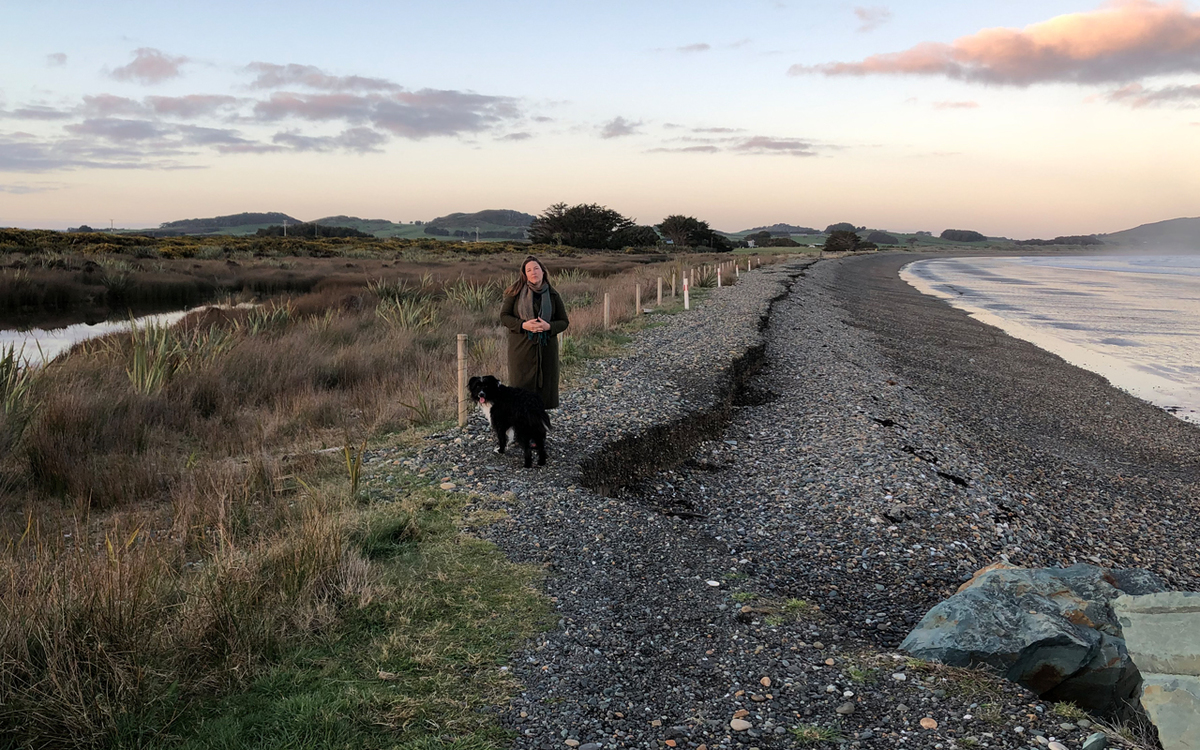‘We’re not here to debate’: Southland mayor shuts down discussion over Colac Bay erosion
Local Democracy Reporter
29 October 2021, 4:36 AM
 Gemma McGrath pictured next to the wetland. McGrath has a masters degree in science communication and actively monitors the bay's Hector's dolphin population. Photo: Chris Cleaver
Gemma McGrath pictured next to the wetland. McGrath has a masters degree in science communication and actively monitors the bay's Hector's dolphin population. Photo: Chris CleaverFears an old dump site could seep into the ocean has one Southland councillor scratching his head over the lack of urgent action to put in safeguards.
Meanwhile, the mayor maintains progress is being made behind the scenes, even though erosion has accelerated since the issue came on the radar "a number of years ago".
On Wednesday, Colac Bay/Ōraka resident Gemma McGrath presented at a Southland District Council meeting, highlighting concerns about an old dump site next to a rapidly eroding coastal road.
Advertisement: Mee Henry Law
McGrath, a dolphin researcher, fears for the Hector’s dolphin population she actively monitors at Colac Bay/Ōraka, about 40 minutes west of Invercargill.
According to more than 10 written statements provided by past and present residents, the dump site contains toxic waste from the time it was managed by the now defunct Wallace County Council.
Residents claim the regenerated wetland is home to a plethora of unwanted refuse, including old car bodies, batteries, plastics, oil, tyres, herbicides and paint.

Bottlenose dolphins swimming out from the dump site last month. Photo: Laura Smith/ODT
However, at a council meeting this week, councillor Don Byars’ comments that the council should add protection instead of risking an ecological disaster were shut down by Mayor Gary Tong.
Tong made it clear the written statements about contaminants at the site were not "formal affidavits", before cutting Byars off.
"We're not here to debate, we’re here to ask questions of the submitter," Tong said.
"It's a big issue and it’s been talked about around this table for a number of years."
Advertisement: WaterForce Southland
Byars responded by saying the fact the issue had been on the table that long was "the problem".
The land in question is owned by the Ōraka Aparima Rūnaka, but responsibility for the crumbling road falls under the council’s jurisdiction.
Tong said he had spoken with the rūnaka this week, and an investigation into the groundwater at the site would be conducted.
Earlier this month, rūnaka kaihautu Riki Dallas told Local Democracy Reporting he would like the council to provide evidence of what was at the site before conclusions were jumped to about toxic waste.
Advertisement: Kathryn Hishon Todd Real Estate Fiordland
At Wednesday’s council meeting, McGrath became emotional as she addressed councillors about the potential for things to turn south if action wasn’t taken soon.
"Colac Bay Hector’s dolphins, the surf break 'Trees', kaimoana and the entire coastal ecosystem are at stake," she said.
"The wetland which drains the dump area is merely metres from the ocean. Toxins may well have accumulated in the sediment under this wetland."
On Thursday, Tong said the comment from Byars suggesting the rock wall be extended in front of the dump site was not appropriate considering a report conducted by NIWA in July 2015 suggested rocks positioned at that point would create more water disturbance.

Southland Mayor Gary Tong hopes testing can begin at the site within the next few weeks. Photo: Laura Smith/ODT
Tong said he hoped testing at the site could be conducted within the next few weeks.
Colac Bay/Ōraka's eroding foreshore has been a matter of contention ever since a large section of Colac Foreshore Rd washed away six years ago.
The section of the road in front of the old dump site was first closed on July 5, 2015 after being damaged by tides.
It then reopened as a single-lane gravel road, before closing again on December 21, 2015.
Residents Deen and Alan McKay have spearheaded efforts to get the road reopened, but have shifted their attention to protecting the dump site.
In June, they approached past and present residents for written statements about the contents of the dump site.
Colac Bay/Ōraka is home to about 60 permanent residents, and is a popular holiday destination.
Matthew Rosenberg
Local Democracy Reporting Editor
Republished by Arrangement







